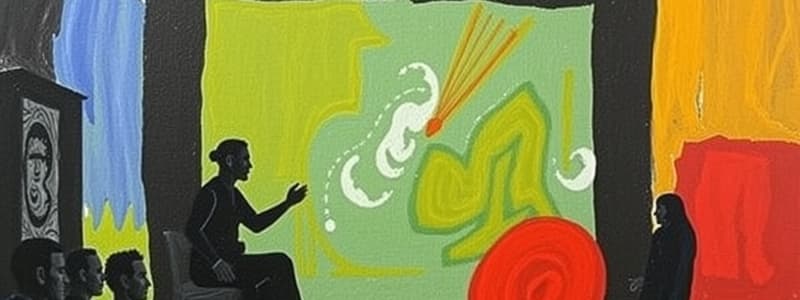Podcast
Questions and Answers
Classical drama began in _____.
Classical drama began in _____.
Greece
Three types of plays that grew from the Christian church were: _____. (Select all that apply)
Three types of plays that grew from the Christian church were: _____. (Select all that apply)
- Mystery plays (correct)
- Comedies
- Tragedies
- Miracle plays (correct)
- Classical drama
- Morality plays (correct)
During the end of the Roman Empire, drama fell out of favor with the church.
During the end of the Roman Empire, drama fell out of favor with the church.
True (A)
Which are some modern variations or experimental ideas used in twentieth-century plays?
Which are some modern variations or experimental ideas used in twentieth-century plays?
Roman dramatists imitated their Greek predecessors.
Roman dramatists imitated their Greek predecessors.
Explain how the church both nearly destroyed drama and also helped revive drama.
Explain how the church both nearly destroyed drama and also helped revive drama.
What are the two classical, basic forms of drama as symbolized by the smiling and frowning masks?
What are the two classical, basic forms of drama as symbolized by the smiling and frowning masks?
Shakespeare was a(n) _____ dramatist.
Shakespeare was a(n) _____ dramatist.
In the classical tradition, comedies may not be 'funny' and still be considered a comedy.
In the classical tradition, comedies may not be 'funny' and still be considered a comedy.
The Roman church reintroduced drama during the Middle Ages.
The Roman church reintroduced drama during the Middle Ages.
The problem in a play is the _____.
The problem in a play is the _____.
The 'point of no return' in the play is the _____.
The 'point of no return' in the play is the _____.
The conclusion of the story is the _____.
The conclusion of the story is the _____.
The stage and props together are called the _____.
The stage and props together are called the _____.
Arrange in order the elements of plot.
Arrange in order the elements of plot.
A dramatic device used to create a realistic atmosphere for a play is called a dramatic convention.
A dramatic device used to create a realistic atmosphere for a play is called a dramatic convention.
Compare and contrast a soliloquy and an aside.
Compare and contrast a soliloquy and an aside.
Flashcards are hidden until you start studying
Study Notes
Origins of Classical Drama
- Classical drama began in Greece, establishing the foundations of theatrical arts.
Types of Medieval Plays
- Three significant types of plays that emerged from the Christian church are Miracle plays, Mystery plays, and Morality plays.
Decline of Drama
- During the end of the Roman Empire, drama lost popularity within the church due to its pagan associations.
Twentieth-Century Innovations
- In modern theater, experimental plays often feature little plot or action and can utilize no script, focusing on improvisation instead.
Roman Influence
- Roman dramatists largely imitated their Greek predecessors, borrowing styles and themes.
Church's Role in Drama
- The church initially nearly destroyed drama due to its pagan roots but later revitalized it by staging biblical events.
Basic Forms of Drama
- The two fundamental forms of drama represented by the smiling and frowning masks are Comedy and Tragedy.
Shakespeare's Era
- Shakespeare is categorized as a Renaissance dramatist, contributing significantly to the evolution of drama.
Nature of Comedy
- In classical tradition, a comedy does not necessarily have to be humorous to be classified as such.
Reintroduction of Drama
- The Roman church played a vital role in reintroducing drama during the Middle Ages.
Elements of a Play
- The problem in a play is centered around the complication, which drives the narrative forward.
Crisis in Drama
- The "point of no return" in the storyline is referred to as the crisis, often leading to pivotal moments.
Conclusion of the Story
- The conclusion of a story is known as the denouement, where resolutions and outcomes are presented.
Stage and Props
- The combination of the stage and props is referred to as the set, creating the visual environment for plays.
Elements of Plot Order
- The order of the elements of plot is: exposition, complication, climax, and denouement.
Dramatic Conventions
- A dramatic device that creates a realistic atmosphere in plays is termed as a dramatic convention.
Soliloquy vs. Aside
- A soliloquy is a lone speech delivered by a character, not directed to others. In contrast, an aside is a brief remark intended for the audience, with both involving a single character addressing their thoughts or opinions.
Studying That Suits You
Use AI to generate personalized quizzes and flashcards to suit your learning preferences.




